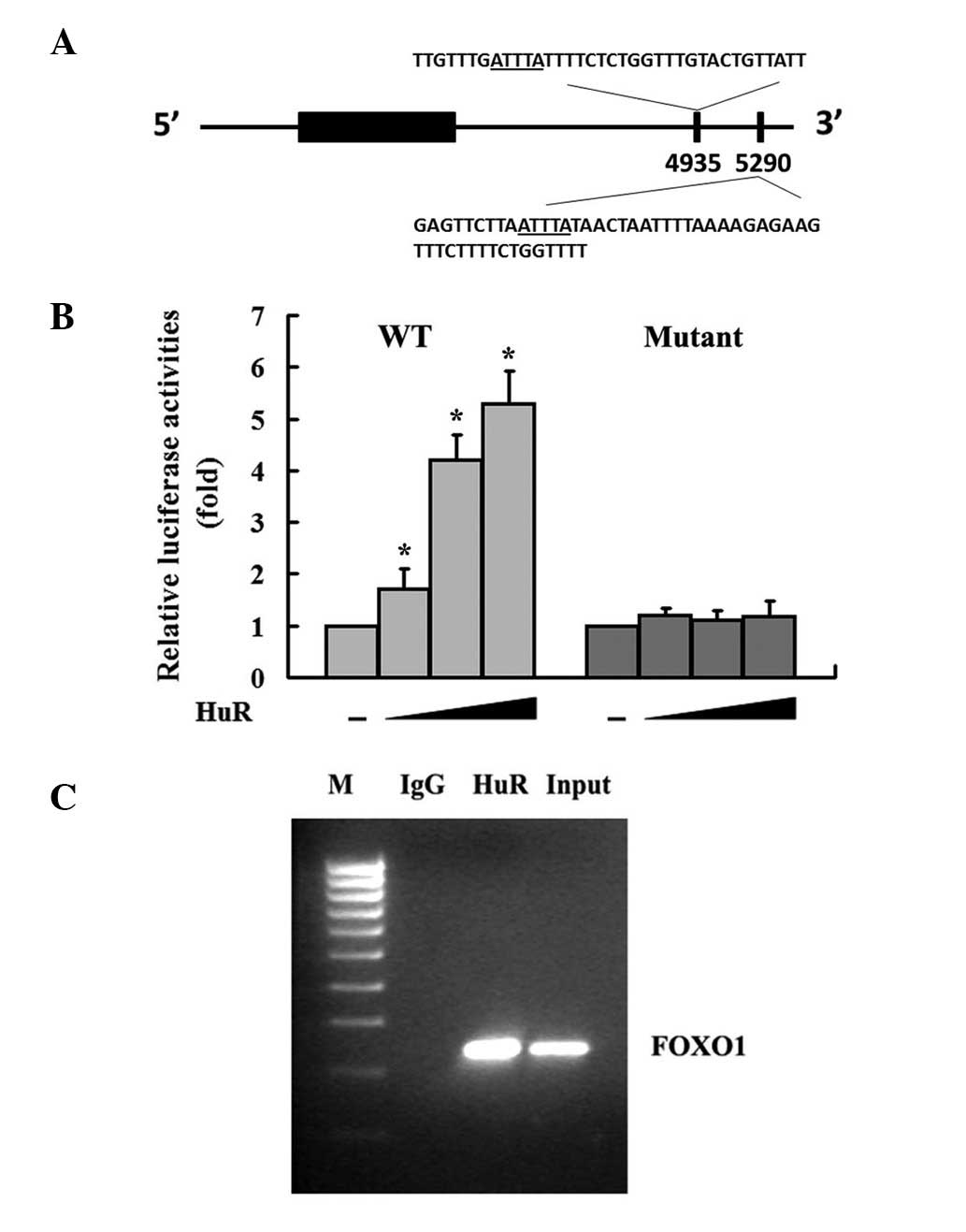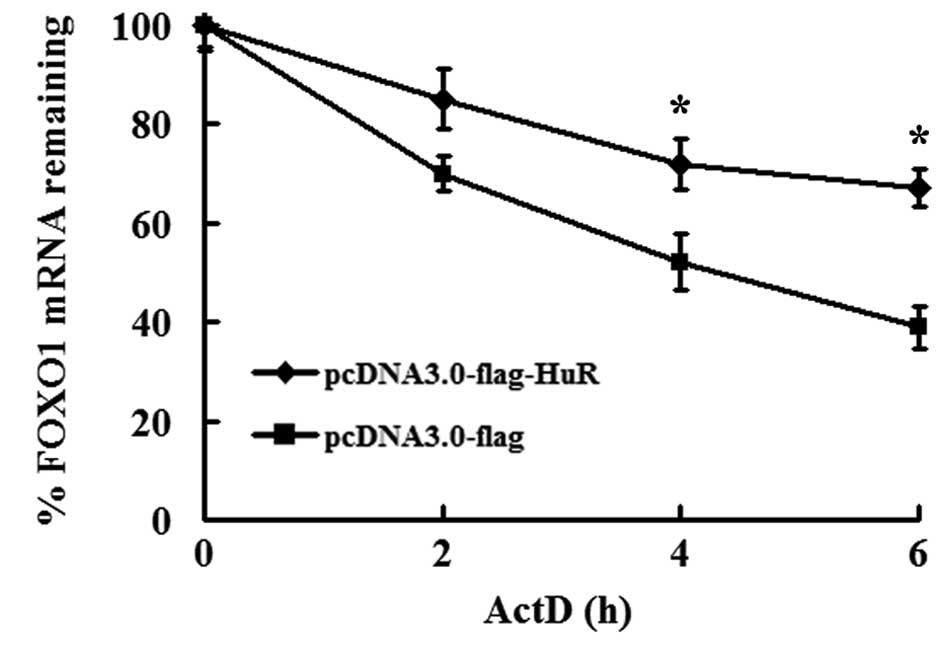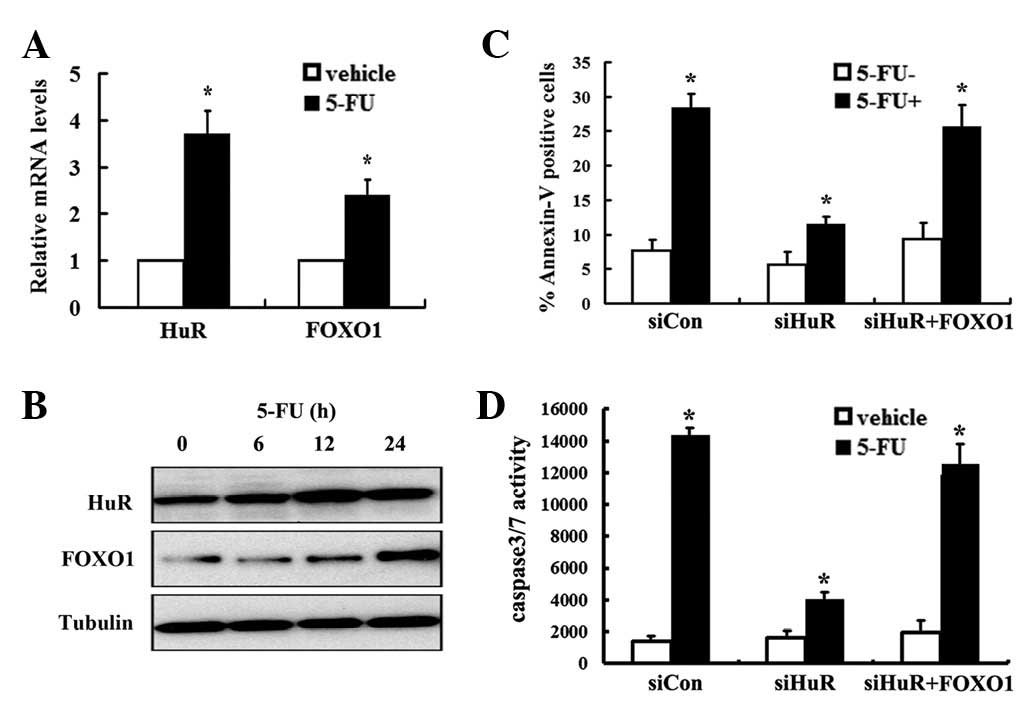|
1.
|
Moore MJ: From birth to death: the complex
lives of eukaryotic mRNAs. Science. 309:1514–1518. 2005. View Article : Google Scholar : PubMed/NCBI
|
|
2.
|
Keene JD: RNA regulons: coordination of
post-transcriptional events. Nat Rev Genet. 8:533–543. 2007.
View Article : Google Scholar : PubMed/NCBI
|
|
3.
|
Brennan CM and Steitz JA: HuR and mRNA
stability. Cell Mol Life Sci. 58:266–277. 2001. View Article : Google Scholar : PubMed/NCBI
|
|
4.
|
Gorospe M: HuR in the mammalian genotoxic
response: post-transcriptional multitasking. Cell Cycle. 2:412–414.
2003. View Article : Google Scholar : PubMed/NCBI
|
|
5.
|
Fan XC and Steitz JA: Overexpression of
HuR, a nuclear-cytoplasmic shuttling protein, increases the in vivo
stability of ARE-containing mRNAs. EMBO J. 17:3448–3460. 1998.
View Article : Google Scholar : PubMed/NCBI
|
|
6.
|
Blackshear PJ: Tristetraprolin and other
CCCH tandem zinc-finger proteins in the regulation of mRNA
turnover. Biochem Soc Trans. 30:945–952. 2002. View Article : Google Scholar : PubMed/NCBI
|
|
7.
|
Heinonen M, Bono P, Narko K, et al:
Cytoplasmic HuR expression is a prognostic factor in invasive
ductal breast carcinoma. Cancer Res. 65:2157–2161. 2005. View Article : Google Scholar : PubMed/NCBI
|
|
8.
|
Wang W, Furneaux H, Cheng H, et al: HuR
regulates p21 mRNA stabilization by UV light. Mol Cell Biol.
20:760–769. 2000. View Article : Google Scholar : PubMed/NCBI
|
|
9.
|
Zou T, Mazan-Mamczarz K, Rao JN, et al:
Polyamine depletion increases cytoplasmic levels of RNA-binding
protein HuR leading to stabilization of nucleophosmin and p53
mRNAs. J Biol Chem. 281:19387–19394. 2006. View Article : Google Scholar : PubMed/NCBI
|
|
10.
|
Erkinheimo TL, Lassus H, Sivula A, et al:
Cytoplasmic HuR expression correlates with poor outcome and with
cyclooxygenase 2 expression in serous ovarian carcinoma. Cancer
Res. 63:7591–7594. 2003.PubMed/NCBI
|
|
11.
|
Arden KC: Multiple roles of FOXO
transcription factors in mammalian cells point to multiple roles in
cancer. Exp Gerontol. 41:709–717. 2006. View Article : Google Scholar : PubMed/NCBI
|
|
12.
|
Birkenkamp KU and Coffer PJ: Regulation of
cell survival and proliferation by the FOXO (Forkhead box, class O)
subfamily of Forkhead transcription factors. Biochem Soc Trans.
31:292–297. 2003. View Article : Google Scholar : PubMed/NCBI
|
|
13.
|
Paik JH, Kollipara R, Chu G, et al: FoxOs
are lineage-restricted redundant tumor suppressors and regulate
endothelial cell homeostasis. Cell. 128:309–323. 2007. View Article : Google Scholar : PubMed/NCBI
|
|
14.
|
Adachi M, Osawa Y, Uchinami H, Kitamura T,
Accili D and Brenner DA: The forkhead transcription factor FoxO1
regulates proliferation and transdifferentiation of hepatic
stellate cells. Gastroenterology. 132:1434–1446. 2007. View Article : Google Scholar : PubMed/NCBI
|
|
15.
|
Finlay D, Patel S, Dickson LM, et al:
Glycogen synthase kinase-3 regulates IGFBP-1 gene transcription
through the thymine-rich insulin response element. BMC Mol Biol.
5:152004. View Article : Google Scholar : PubMed/NCBI
|
|
16.
|
Roy SK, Srivastava RK and Shankar S:
Inhibition of PI3K/AKT and MAPK/ERK pathways causes activation of
FOXO transcription factor, leading to cell cycle arrest and
apoptosis in pancreatic cancer. J Mol Signal. 5:102010. View Article : Google Scholar : PubMed/NCBI
|
|
17.
|
Potente M, Fisslthaler B, Busse R and
Fleming I: 11,12-Epoxyeicosatrienoic acid-induced inhibition of
FOXO factors promotes endothelial proliferation by down-regulating
p27Kip1. J Biol Chem. 278:29619–29625. 2003. View Article : Google Scholar : PubMed/NCBI
|
|
18.
|
Sengupta A, Molkentin JD, Paik JH, DePinho
RA and Yutzey KE: FoxO transcription factors promote cardiomyocyte
survival upon induction of oxidative stress. J Biol Chem.
286:7468–7478. 2011. View Article : Google Scholar : PubMed/NCBI
|
|
19.
|
Tang H, Lee M, Budak MT, et al: Intrinsic
apoptosis in mechanically ventilated human diaphragm: linkage to a
novel Fos/FoxO1/Stat3-Bim axis. FASEB J. 25:2921–2936. 2011.
View Article : Google Scholar : PubMed/NCBI
|
|
20.
|
Raghavendra PB, Pathak N and Manna SK:
Novel role of thiadiazolidine derivatives in inducing cell death
through Myc-Max, Akt, FKHR, and FasL pathway. Biochem Pharmacol.
78:495–503. 2009. View Article : Google Scholar : PubMed/NCBI
|
|
21.
|
Tran H, Brunet A, Griffith EC and
Greenberg ME: The many forks in FOXO’s road. Sci STKE: RE5.
2003.
|
|
22.
|
Nakae J, Biggs WH 3rd, Kitamura T, et al:
Regulation of insulin action and pancreatic beta-cell function by
mutated alleles of the gene encoding forkhead transcription factor
Foxo1. Nat Genet. 32:245–253. 2002. View
Article : Google Scholar : PubMed/NCBI
|
|
23.
|
Liu P, Kao TP and Huang H: CDK1 promotes
cell proliferation and survival via phosphorylation and inhibition
of FOXO1 transcription factor. Oncogene. 27:4733–4744. 2008.
View Article : Google Scholar : PubMed/NCBI
|
|
24.
|
Wu Y, Shang X, Sarkissyan M, Slamon D and
Vadgama JV: FOXO1A is a target for HER2-overexpressing breast
tumors. Cancer Res. 70:5475–5485. 2010. View Article : Google Scholar : PubMed/NCBI
|
|
25.
|
Abdelnour-Berchtold E, Cerantola Y, Roulin
D, Dormond-Meuwly A, Demartines N and Dormond O: Rapamycin-mediated
FOXO1 inactivation reduces the anticancer efficacy of rapamycin.
Anticancer Res. 30:799–804. 2010.PubMed/NCBI
|
|
26.
|
Zhang H, Pan Y, Zheng L, et al: FOXO1
inhibits Runx2 transcriptional activity and prostate cancer cell
migration and invasion. Cancer Res. 71:3257–3267. 2011. View Article : Google Scholar : PubMed/NCBI
|













